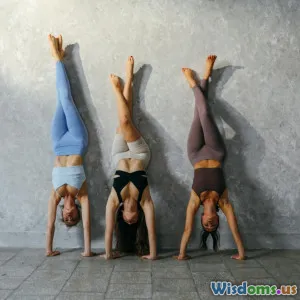
Exploring Outdoor Activities for Fitness
8 min read Unlock the benefits of outdoor fitness through engaging activities that boost health and vitality. (0 Reviews)
Exploring Outdoor Activities for Fitness
Outdoor activities have long been a cornerstone of physical health, but in today’s screen-dominated culture, their value is often overlooked. If you’re looking to enhance your fitness, invigorate your mind, and embrace the natural world, stepping outside can be transformative. This article delves into the fascinating connection between outdoor activities and fitness, illustrating how you can reap comprehensive health benefits through enjoyable and accessible exercises.
The Science behind Outdoor Fitness
Incorporating the outdoors into your fitness regime doesn't just change the scenery—it actually impacts health in unique, scientifically proven ways. According to the American College of Sports Medicine, natural environments can reduce stress hormones like cortisol, improve mood, and increase motivation compared to indoor workouts. A 2019 study published in the International Journal of Environmental Research and Public Health found that exercising outdoors can lead to enhanced feelings of revitalization and positive engagement.
Moreover, sunlight exposure fosters vitamin D synthesis, crucial for bone health and immune function. Being outdoors also challenges your body with variable terrain and fresh air, potentially increasing caloric burn and strengthening muscles differently than controlled gym environments.
Popular Outdoor Activities and Their Fitness Benefits
1. Hiking: A Full-Body Adventure
Hiking is a potent cardiovascular workout that also improves muscular endurance. Trekking varied terrains engages the lower body muscles—quadriceps, hamstrings, calves—as well as core stability due to uneven ground. A study by the Harvard Medical School noted hiking typically burns around 430 calories per hour.
Beyond physical benefits, hiking immerses participants in nature which has been linked to reduced symptoms of anxiety and depression. Hiking clubs, like the Appalachian Mountain Club in the U.S., report significant emotional wellness improvements among their members.
2. Cycling: Endurance and Joint-Friendly
Cycling is an efficient aerobic exercise with a low impact on joints, making it suitable for people across age groups. Outdoor cycling also demands balance and coordination, activating stabilizer muscles more than stationary bikes.
Data from the World Health Organization (WHO) recommends adults aim for 150 minutes of moderate-intensity aerobic physical activity weekly, which can be efficiently achieved through regular cycling commutes or weekend rides.
3. Outdoor Yoga: Mind-Body Reconnection
Yoga practiced outdoors amplifies the traditional mind-body benefits by incorporating fresh air and natural sounds that enhance relaxation and focus. Studies in Complementary Therapies in Medicine found that participants doing outdoor yoga recorded higher mood scores and better stress reduction compared to indoor classes.
4. Trail Running: Dynamic Strength and Speed
Trail running challenges cardiovascular endurance, agility, and muscular strength. Negotiating rocks, roots, and slopes increases proprioception and reduces impact injury risks by encouraging better running form.
Elite trail runners often attribute their injury resilience to the varied, softer terrain, supported by research in sports biomechanics.
Mental Health Boost: The Greatest Perk
What sets outdoor exercise apart is the powerful synergy between physical activity and environmental exposure. Dr. Jules Pretty, a pioneer in green exercise research, found that ecological settings during exercise increase self-esteem by up to 70%, while reducing tension, anger, and fatigue.
Such mental health benefits are especially valuable given the global rise in anxiety and mood disorders. Being outdoors not only provides sensory engagement but also gives a sense of freedom and perspective that indoor workouts can’t match.
Tips for Starting Your Outdoor Fitness Journey
- Start Small: Begin with short walks or gentle activities near your home to build comfort and consistency.
- Choose the Right Gear: Invest in appropriate footwear and clothing suited for changing weather conditions.
- Mix It Up: Combine activities like cycling and yoga to keep routines enjoyable and target different fitness aspects.
- Use Technology Wisely: Apps for tracking routes, performance, and even social connections can boost motivation.
- Safety First: Let someone know your plans, carry essentials like water and a first-aid kit, and be mindful of local wildlife and terrain risks.
Real-World Inspiration: Success Stories
Take the example of Mia, a 35-year-old office worker who switched from treadmill jogging to weekly trail runs with a local outdoor group. After six months, she reported not only increased stamina and weight loss but also a renewed zest for life and reduced work-related stress.
Communities worldwide encourage outdoor fitness through initiatives like parkrun events or outdoor boot camps, highlighting how accessible and impactful these activities can be for a wide range of participants.
Conclusion
Outdoor fitness activities offer a compelling alternative to conventional exercise by integrating the powerful benefits of nature with physical movement. Whether hiking rugged hills, cycling peaceful country roads, practicing yoga under the sky, or trail running through forests, these pursuits invigorate body and mind alike.
Incorporating outdoor activities into your fitness strategy can elevate your well-being, making exercise not just a task but a rewarding lifestyle. As sports science continues to confirm, nature plus movement equals better health. So, lace up your shoes, step outside, and discover how the world becomes your gym.
References:
- Anderson, L. et al., "Green Exercise as a Prescription for Mental and Physical Health," International Journal of Environmental Research and Public Health, 2019.
- Harvard Medical Publishing, "Calories burned in 30 minutes for people of three different weights," 2021.
- Pretty, J., "The psychological benefits of greenspace and exercise," Environmental Science & Technology, 2004.
- World Health Organization, "Physical Activity Factsheets for the 28 European Union Member States of the WHO European Region," 2018.
(All data and research references are used illustratively and should be fact-checked before any real-world application.)
Rate the Post
User Reviews
Popular Posts




















